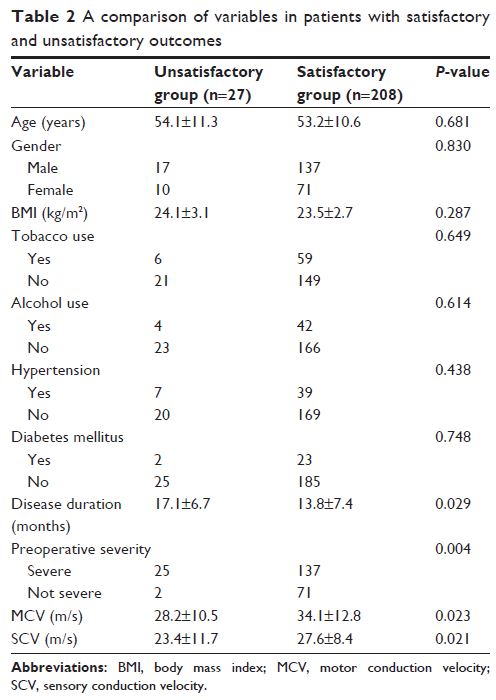9 0 6 7 6
论文已发表
注册即可获取德孚的最新动态
IF 收录期刊
- 2.6 Breast Cancer (Dove Med Press)
- 3.9 Clin Epidemiol
- 3.3 Cancer Manag Res
- 3.9 Infect Drug Resist
- 3.6 Clin Interv Aging
- 4.8 Drug Des Dev Ther
- 2.8 Int J Chronic Obstr
- 8.0 Int J Nanomed
- 2.3 Int J Women's Health
- 3.2 Neuropsych Dis Treat
- 4.0 OncoTargets Ther
- 2.2 Patient Prefer Adher
- 2.8 Ther Clin Risk Manag
- 2.7 J Pain Res
- 3.3 Diabet Metab Synd Ob
- 4.3 Psychol Res Behav Ma
- 3.4 Nat Sci Sleep
- 1.9 Pharmgenomics Pers Med
- 3.5 Risk Manag Healthc Policy
- 4.5 J Inflamm Res
- 2.3 Int J Gen Med
- 4.1 J Hepatocell Carcinoma
- 3.2 J Asthma Allergy
- 2.3 Clin Cosmet Investig Dermatol
- 3.3 J Multidiscip Healthc

尺神经原位松解术治疗肘管综合征的手术结果预测
Authors Kong L, Bai J, Yu K, Zhang B, Zhang J, Tian D
Received 26 October 2017
Accepted for publication 8 December 2017
Published 4 January 2018 Volume 2018:14 Pages 69—74
DOI https://doi.org/10.2147/TCRM.S155284
Checked for plagiarism Yes
Review by Single-blind
Peer reviewers approved by Dr Hoa Le
Peer reviewer comments 2
Editor who approved publication: Professor Deyun Wang
Background: In the treatment of cubital tunnel syndrome (CuTS), in situ ulnar
nerve decompression is commonly used. This study aims to investigate predictive
factors for poor recovery and ulnar nerve instability following this procedure.
Methods: We enrolled 235 patients who underwent in situ
ulnar nerve decompression for the treatment of CuTS from January 2010 to
December 2014. All patients underwent >2 years’ follow-up. The primary
outcome was postoperative recovery, which was assessed by Messina’s criteria,
and the secondary outcome was postoperative ulnar nerve instability. Potential
risk factors were collected from demographic data and electrodiagnostic test,
which included age, gender, body mass index, history of tobacco or alcohol use,
history of major medical comorbidities, disease duration, preoperative
severity, motor conduction velocity, and sensory conduction velocity.
Results: A total of 208 patients (88.5%) had satisfactory
outcomes, while the other 27 patients (11.5%) had not. There were 25 patients
(10.6%) showing postoperative ulnar nerve instability during follow-up. The
multivariate analysis showed that only severe preoperative symptom (odds ratio
[OR], 3.06; 95% confidence interval [CI], 2.16–4.32) was associated with
unsatisfactory postoperative outcomes in patients with CuTS (P <0.001). In the model
investigating independent factors associated with postoperative ulnar nerve
instability, we found that young age (OR, 2.41; 95% CI, 1.63–3.58) was
associated with the incidence of postoperative ulnar nerve instability (P <0.001).
Conclusion: We found that severe preoperative symptom was
associated with unsatisfactory postoperative outcomes, and young age was a risk
factor for the incidence of postoperative ulnar nerve instability. Patients
with these risk factors should be informed of the possibility of worse surgical
outcomes.
Keywords: predictors,
cubital tunnel syndrome, ulnar nerve decompression, multivariate analysis
